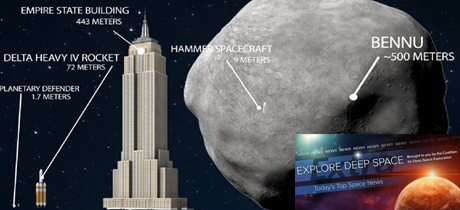In Today’s Deep Space Extra… Russia’s soyuz, currently the only means of transporting cosmonauts and astronauts to and from the International Space Station (ISS) resumed launches Monday in the aftermath of an October 11 launch abort. After a more than two years journey, NASA’s Osiris Rex asteroid sample return mission spacecraft reached its destination, Bennu, on Monday.
Human Space Exploration
After aborted mission in October, 3 astronauts arrive to International Space Station (ISS)
Orlando Sentinel (12/3): NASA’s Anne McClain, Canada’s David Saint-Jacques and Russia’s Oleg Kononenko launched to the International Space Station (ISS) early Monday, marking a return to flight for Russia’s soyuz spacecraft following an October 11 abort two minutes into flight with a NASA astronaut and Russian cosmonaut. Both men landed safely, but the October 11 incident temporarily suspended the world’s only means of launching humans into space. The trio launched aboard the soyuz MS-11 from the Baikonur Cosmodrome in Kazakhstan at 6:31a.m., EST, and docked to the Space Station at 12:33 p.m., EST, for a 6 1/2 month tour of duty.
NASA astronaut Nick Hague set for new Space Station mission after abort
NASA (12/3): As Russia’s soyuz rocket resumed the launching of human crews to the International Space Station (ISS) on Monday, NASA announced that U.S. astronauts Nick Hague and Christina Hammock Koch and Russia’s Alexey Ovchinin will follow, with the launch of the soyuz MS-12 on February 28. Hague and Ovchinin were aboard the soyuz MS-10 as it aborted two minutes into flight over Kazakhstan on October 11. Both men were recovered from the Kazakh plains and found to be in good shape and eligible to fly once the cause of the mishap was investigated and the Russian rockets returned to flight.
SpaceX cargo launch slips a day after rodent experiment snag
Spaceflightnow.com (12/4): The launch of SpaceX’s 16th NASA contracted resupply mission to the International Space Station (ISS) has been delayed from Tuesday to Wednesday for the change out of moldy food for a rodent experiment. The 40 mice are subjects in experiments assessing the effect of low gravity on the immune, bone and muscle systems. The Falcon 9/Dragon cargo mission with about 5,700 pounds of supplies is to liftoff from Cape Canaveral Air Force Station, Florida, at 1:16 p.m., EST.
Space Science
A congressman’s loss clouds the future of two demanding missions to Europa
Ars Technica (12/3): U.S. Representative John Culberson, an advocate for NASA’s robotic exploration of Jupiter’s geologically active, ice and ocean covered moon Europa — the host to a potentially habitable environment — was defeated in his bid for re-election in the November mid-term. The Houston lawmaker was openly accused or placing science above flood control by opponents. Culberson chairs the House appropriations subcommittee with jurisdiction over NASA and NOAA, a post he will relinquish in January. His departure leaves the fate of Europa Clipper, a multiple flyby mission and a follow on Europa lander, envisioned for launches in July 2023 and possibly in late 2026 respectively, in doubt. In late November, the congressman made a final visit to NASA’s Jet Propulsion Laboratory for a status report and an opportunity to express his support to those developing the two missions.
NASA is about to grab a piece of an asteroid. That’s even harder than it sounds
Washington Post (12/3): NASA’s Osiris Rex spacecraft reached its asteroid sample return destination, the near Earth object Bennu, on Monday at mid-day. After a lengthy close up reconnaissance of Bennu for the selection of a landing site, Osiris-Rex is to descend to the surface in mid-2020 to collect surface soil and rocks. The robotic spacecraft, launched in September 2016, is due back at Earth in late 2023 and is send a sample canister with the asteroid material toward the U.S. Army Test and Training Range in Utah for recovery on September 24, 2023.
Other News
Congress to extend appropriations continuing resolution for two more weeks
Spacepolicyonline.com (12/3): Much of the U.S. federal government is without a budget for the 2019 fiscal year that began October 1, including NASA and NOAA and other civilian agencies. Unable to agree on a budget, Congress passed a budget continuing resolution, or CR, allowing spending to continue at 2018 levels until this Friday at midnight. With Washington tributes to the late president George H.W. Bush under way this week and tensions between the White House and Congress over the construction of a Border Wall stirring, it seems likely the current CR will be extended until December 21.
Coalition Members in the News – Astrobotic Technology, Inc., Deep Space Systems, Lockheed Martin
Space Review (12/3): NASA has selected a diverse lot of nine companies to provide up to a potential $2.6 billion in lunar surface payload delivery services over the next decade. NASA’s intent, outlined during an announcement last week, is to gradually build up a capability suitable to place human explorers as well as robotic rovers and landers on the Moon. Initially, low mass payloads for science and exploration missions could begin launching in 2020.

